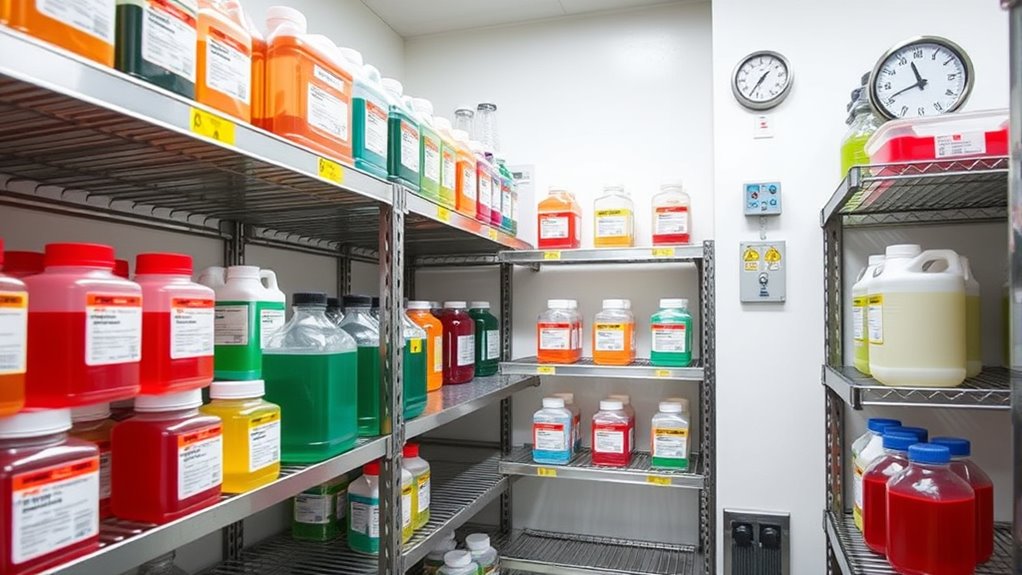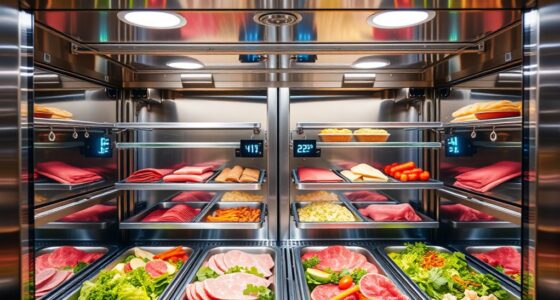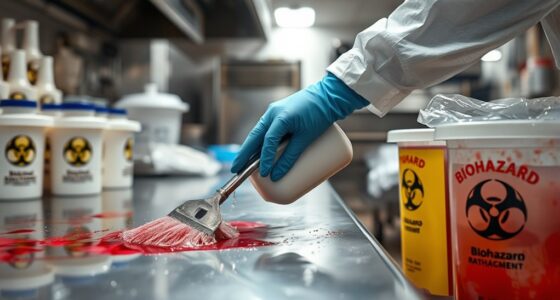To guarantee safe chemical storage in foodservice, you should store chemicals in designated, secure areas away from food and utensils, using proper containers that are resistant to corrosion. Clearly label all containers with hazard warnings and avoid mixing incompatible substances. Regularly inspect storage areas for leaks or damage, maintain proper documentation, and train staff on safety procedures. Establish clear protocols for spills and emergencies—continuing supports your understanding of maintaining compliance and safety.
Key Takeaways
- Store chemicals in designated, secure areas away from food, utensils, and prep zones to prevent contamination and accidents.
- Properly label all containers with chemical names, hazard warnings, and dates using durable, waterproof labels.
- Segregate hazardous and non-hazardous chemicals to prevent dangerous reactions and facilitate safe handling.
- Use appropriate, corrosion-resistant containers made of high-density polyethylene, stainless steel, or glass to ensure chemical stability.
- Conduct regular inspections for leaks, damage, and expiry dates, and maintain detailed records of storage practices and staff training.
Understanding the Importance of Proper Chemical Storage
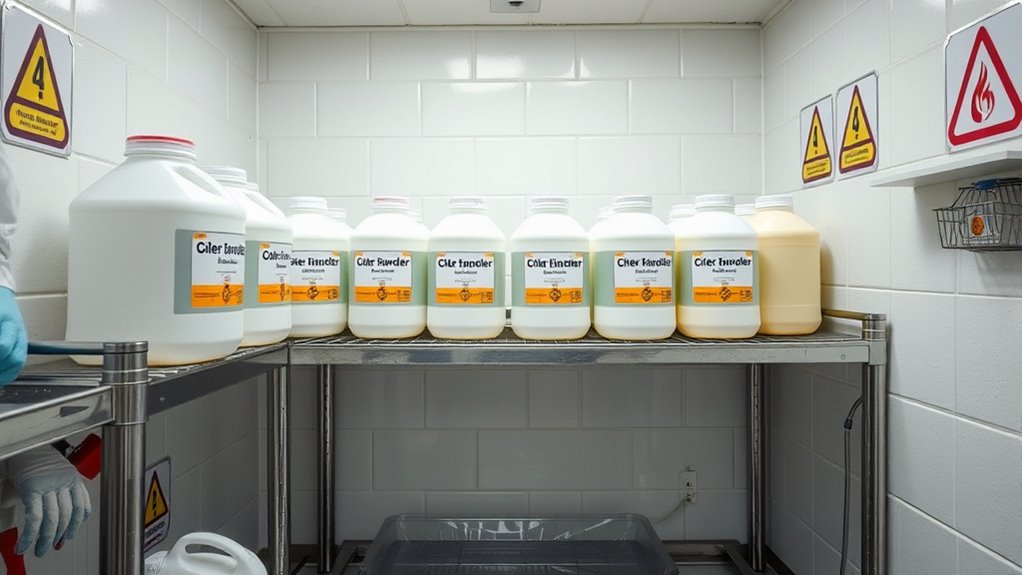
Proper chemical storage is essential for maintaining safety and ensuring compliance in foodservice operations. When chemicals aren’t stored correctly, accidents can happen, leading to injuries, contamination, or regulatory fines. You need to understand the risks involved with improper storage, such as chemical spills, leaks, or reactions with other substances. Proper storage helps prevent these hazards by keeping chemicals in clearly labeled, secure containers away from food, water sources, and heat. It also ensures that staff can quickly find and handle chemicals safely, reducing the chance of misuse. Additionally, adhering to storage protocols keeps your operation compliant with health and safety regulations, avoiding penalties. Prioritizing proper chemical storage isn’t just about safety; it’s about protecting your team, customers, and business reputation. Implementing proper storage practices also helps maintain chemical stability, preventing dangerous reactions and ensuring the effectiveness of the chemicals used.
Identifying Common Chemicals Used in Foodservice Environments
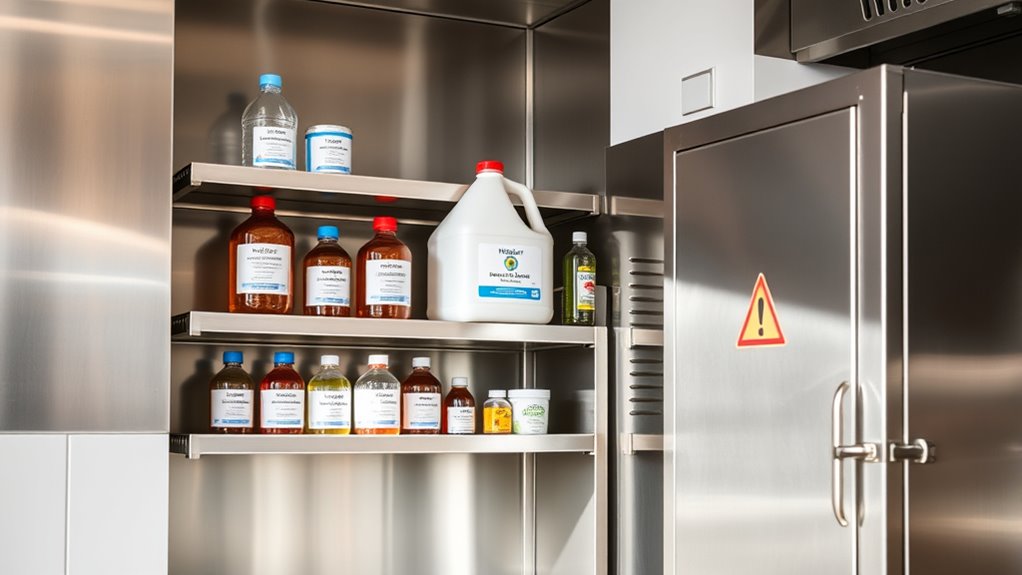
In foodservice environments, you’ll encounter a variety of chemicals, including cleaning and sanitizing agents, food processing chemicals, and storage supplies. Recognizing these substances helps you handle them safely and keep your workplace compliant. Knowing what’s used around you is the first step in proper chemical management. For example, understanding precious metals investment options can inform broader financial planning and asset diversification outside of immediate safety concerns.
Cleaning and Sanitizing Agents
Cleaning and sanitizing agents are essential tools in foodservice environments to maintain safety and hygiene. Common cleaning chemicals include detergents, degreasers, and alkaline cleaners, which break down grease, dirt, and food residues. Sanitizers, such as chlorine-based compounds, quaternary ammonium, and iodine solutions, are used to reduce bacteria and viruses on surfaces. You should always follow manufacturer instructions for proper use, dilution, and contact time. Store these chemicals separately from food and in clearly labeled containers to prevent cross-contamination. Use personal protective equipment like gloves and goggles to protect yourself during handling. Regularly inspect storage areas to ensure chemicals are in good condition and not expired. Properly labeling and segregating cleaning and sanitizing agents help maintain a safe, compliant foodservice environment. Wall organization systems can also be utilized to keep storage areas tidy and accessible, reducing the risk of accidental mix-ups.
Food Processing Chemicals
Food processing chemicals are vital for maintaining safety and efficiency in foodservice operations. These chemicals include preservatives, pH adjusters, antioxidants, and anti-microbial agents used to extend shelf life, improve texture, and guarantee product safety. Common preservatives like sodium benzoate and potassium sorbate help prevent microbial growth, while acids such as citric acid and vinegar control pH levels. Antioxidants like ascorbic acid prevent spoilage caused by oxidation. You might also use enzymes to break down proteins or fats, aiding in processing. It’s essential to handle these chemicals carefully, store them properly, and follow manufacturer instructions. Proper management ensures they serve their purpose without contaminating food or posing health risks to staff or customers. Additionally, understanding the role of color accuracy in food presentation can help improve visual appeal and customer satisfaction.
Storage and Handling Supplies
Proper storage and handling of chemicals used in foodservice environments help prevent contamination and guarantee safety. To do this effectively, you need the right supplies, such as labeled bottles, secondary containment trays, and secure cabinets. Store chemicals separately based on their use—cleaning agents away from food and beverages—to avoid cross-contamination. Use color-coded labels to quickly identify chemicals and prevent mix-ups. Always keep caps tight and containers upright to avoid leaks. When handling chemicals, wear appropriate personal protective equipment like gloves and goggles. Regularly inspect storage areas for spills or damaged containers. Proper storage practices also include understanding the vetted safety standards and recommendations to ensure compliance and safety. Training staff on proper handling procedures ensures everyone follows safety protocols. By using proper supplies and techniques, you minimize risks and maintain a safe foodservice environment.
Designing a Safe Storage Area for Chemicals
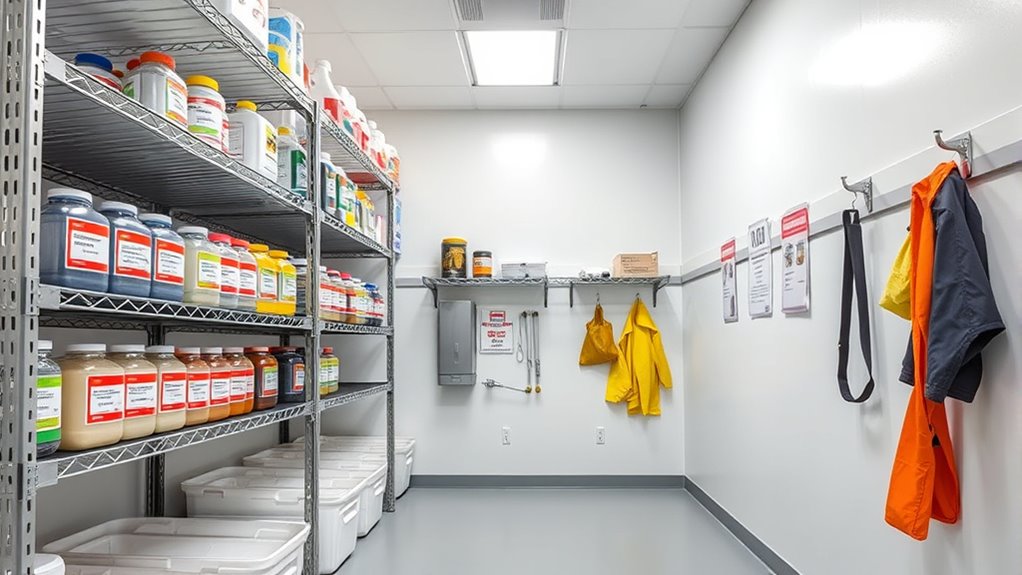
Have you considered how to create a storage area that keeps chemicals safe and prevents accidents? A well-designed space minimizes risks and makes handling chemicals easier. Start by choosing a cool, dry, and well-ventilated location away from food prep areas. Use sturdy shelving to prevent tipping or spills, and separate chemicals by type—like acids and cleaners—to avoid dangerous reactions. Keep emergency equipment, such as spill kits and fire extinguishers, nearby and accessible. Label shelves clearly so you know where everything belongs. Regularly inspect the area for leaks, corrosion, or damage. Proper chemical storage safety is essential for maintaining a secure environment. Remember, a tidy, organized storage space not only keeps everyone safe but also makes your workflow smoother. Proper design is key to preventing accidents and ensuring compliance with safety standards.
Labeling and Signage Requirements for Chemical Containers

Are you aware of the critical importance of clear labeling and signage on chemical containers? Proper labels help prevent accidents by providing essential information at a glance. You should guarantee each container has a legible label displaying the chemical’s name, hazard warnings, and handling instructions. Use standardized symbols and color codes to quickly communicate risks. Signage in storage areas must clearly identify hazardous zones and specify safety precautions. Labels should be durable, waterproof, and resistant to chemicals, so they remain intact over time. Proper labeling not only helps you and staff identify substances easily but also complies with safety regulations. Consistent, clear signage minimizes confusion, reduces the risk of misuse, and promotes a safer work environment in your foodservice operation. Additionally, understanding cookie categories and user consent management can improve communication and safety protocols in your facility.
Segregation of Hazardous and Non-Hazardous Substances
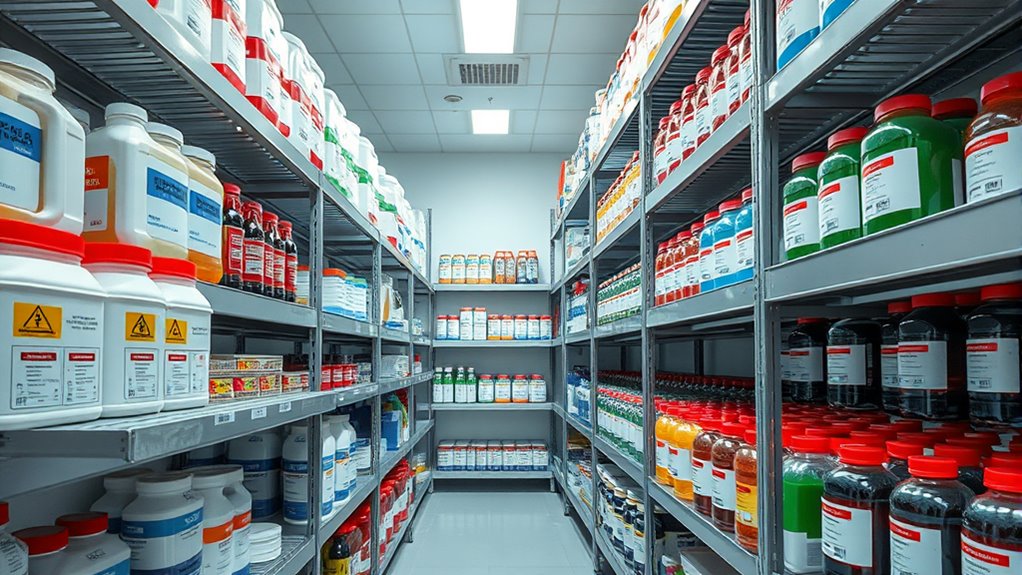
To prevent accidents and guarantee safety, it’s essential to keep hazardous and non-hazardous substances separated in storage areas. Mixing these can lead to dangerous chemical reactions or accidental exposure. You should designate specific zones for each type, clearly marking them for easy identification. Always store hazardous chemicals away from food, utensils, and cleaning supplies to avoid cross-contamination. Use physical barriers or separate shelving units to reinforce separation. Regularly inspect storage areas to ensure segregation is maintained and labels are intact. Proper segregation reduces the risk of spills, leaks, and accidental misuse. Remember, clear organization and consistent practices are critical in creating a safe foodservice environment. Implementing proper chemical storage procedures can further enhance safety protocols.
Using Appropriate Containers and Storage Equipment
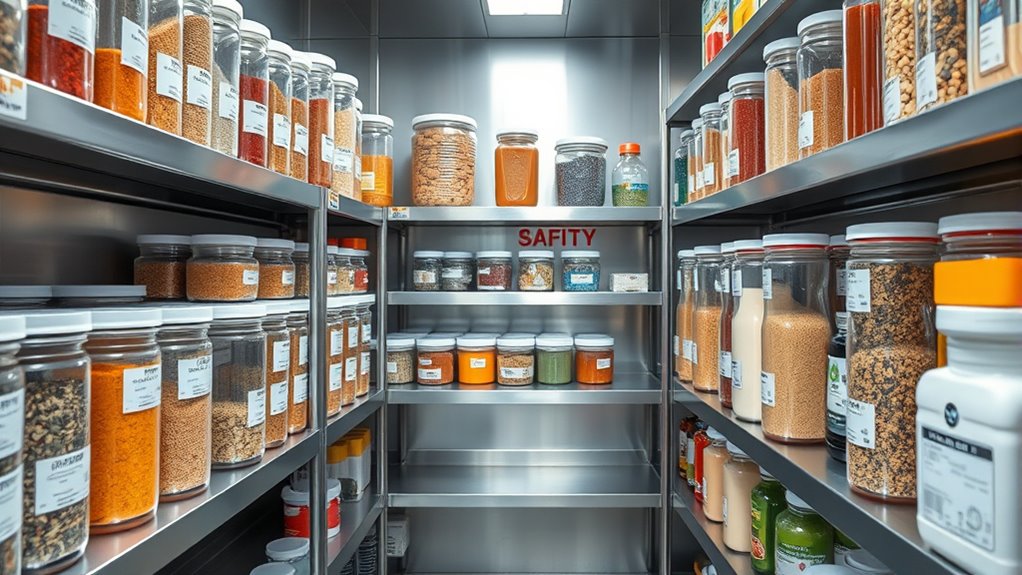
Choosing the right containers and storage equipment is essential to keep chemicals safe and effective. You need to select materials that won’t react with the substances and guarantee proper labeling so everyone knows what’s inside. By doing this, you minimize risks and maintain a safe foodservice environment. Additionally, selecting containers made from appropriate materials ensures chemical stability and prevents contamination.
Container Material Selection
Selecting the right containers and storage equipment is essential for maintaining food safety and quality. The material of your storage containers plays a critical role in preventing chemical reactions, contamination, and spoilage. Choose containers made from food-grade materials like high-density polyethylene, stainless steel, or glass, which resist corrosion and are non-reactive. Avoid using containers that previously held incompatible chemicals or materials, as residues can cause contamination. Proper container material selection ensures easy cleaning, durability, and chemical resistance. Consider the nature of the chemical stored and select containers that won’t degrade or leach harmful substances into your chemicals or food. This careful choice helps maintain a safe environment and preserves the integrity of your stored items. Additionally, selecting containers with diverse designs and materials can enhance your storage efficiency and safety.
Proper Labeling Practices
Have you ever considered how proper labeling can prevent chemical mishaps in foodservice? Clear, accurate labels ensure everyone knows what’s inside each container, reducing the risk of misuse or cross-contamination. Always use legible labels with the chemical’s name, date received, and expiration date if applicable. Include hazard warnings if necessary, so staff handle substances safely. Use appropriate containers that match the chemical’s storage requirements, such as non-reactive materials, and keep labels visible at all times. Regularly check labels for wear or damage and replace them immediately. Proper labeling not only helps maintain safety but also streamlines inventory management and ensures compliance with health regulations. Remember, clear labels save time, prevent accidents, and protect both staff and customers.
Implementing Safety Protocols and Staff Training
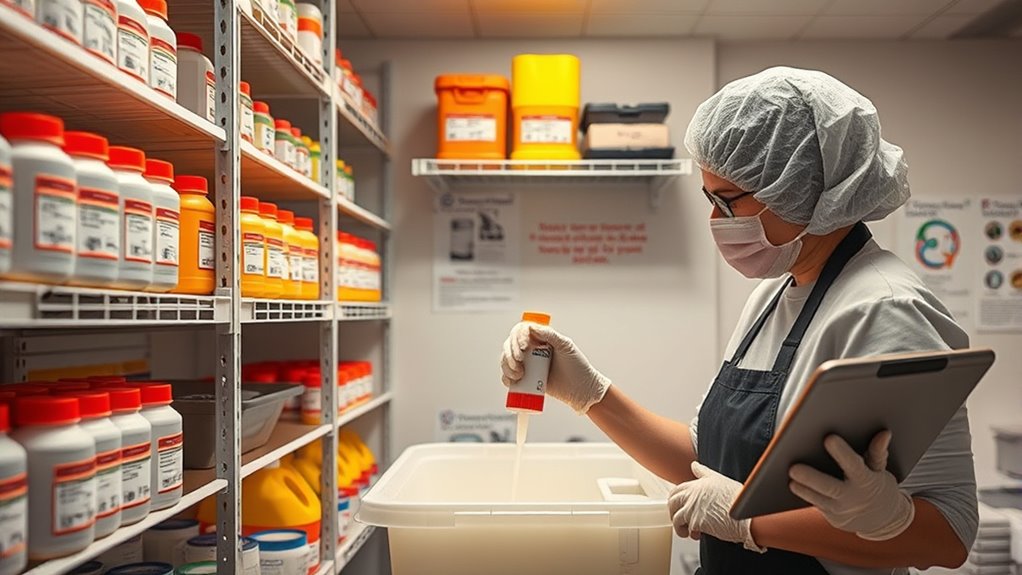
To guarantee safe chemical storage in foodservice settings, implementing robust safety protocols and extensive staff training is essential. You need clear procedures for handling, storing, and disposing of chemicals, making sure everyone understands their responsibilities. Regular training helps staff recognize hazards and respond appropriately to emergencies. You should also conduct periodic drills to reinforce safety habits.
Implement clear protocols and regular training for safe chemical handling and storage.
Consider these key actions:
- Create detailed safety manuals that outline proper storage and emergency steps.
- Conduct hands-on training sessions regularly to keep staff updated.
- Assign safety responsibilities to specific team members to ensure accountability.
Regular Inspection and Maintenance of Storage Areas
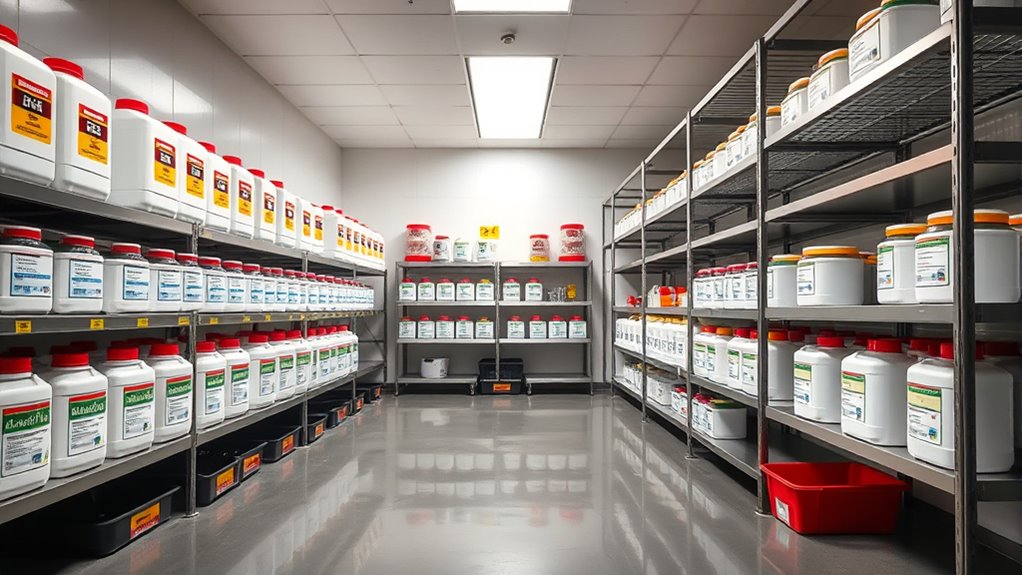
Regular inspections are essential to keep your storage areas safe and compliant. You should schedule routine checks, clean the space regularly, and address any hazards immediately. Doing so helps prevent accidents and guarantees chemicals are stored properly.
Schedule Routine Inspections
Scheduling routine inspections is essential for maintaining a safe and organized foodservice storage area. Regular checks help identify potential hazards early, ensuring chemicals are stored correctly and safely. When you conduct inspections, look for expired products, leaks, or damaged containers that could pose risks. Keep an eye on ventilation and labeling, making sure everything is in its proper place. Consistent inspections also prevent clutter and ensure compliance with safety standards. By sticking to a schedule, you can catch issues before they become serious problems, protecting staff and customers alike. Make it a habit to document your inspections, so you have a record of maintenance and any corrective actions taken. Routine inspections are your first line of defense in keeping your storage area safe and compliant.
Maintain Clean Storage Areas
How often do you check your storage areas to keep them clean and organized? Regular cleaning prevents spills, cross-contamination, and clutter that can hide hazards. Make it a habit to sweep floors, wipe shelves, and remove expired or unnecessary chemicals weekly. Confirm chemicals are stored off the ground and away from food or utensils. Label shelves clearly and keep storage neat so you can quickly spot leaks or damaged containers. Check for signs of corrosion, leaks, or broken bottles during inspections. Maintaining cleanliness not only promotes safety but also extends the life of your storage equipment. Consistent upkeep reduces the risk of accidents and keeps your workspace compliant with safety regulations. Staying proactive in cleaning helps ensure a safe, efficient foodservice environment.
Address Hazards Promptly
To guarantee your storage areas remain safe, you need to inspect them frequently for hazards and perform prompt maintenance when issues arise. Regular checks help catch leaks, corrosion, or damaged containers before they cause bigger problems. Address hazards immediately to prevent chemical spills, contamination, or accidents. Keep an eye out for:
- Leaking or damaged containers that need replacing
- Clutter or blocked access that hampers safety
- Signs of corrosion or chemical deterioration
Taking quick action minimizes risks to staff and food safety. Keep a maintenance log to track inspections and repairs. Prompt responses show your commitment to a safe environment and help avoid costly incidents. Staying proactive ensures your storage remains compliant and safe for everyone.
Emergency Preparedness and Spill Response Procedures
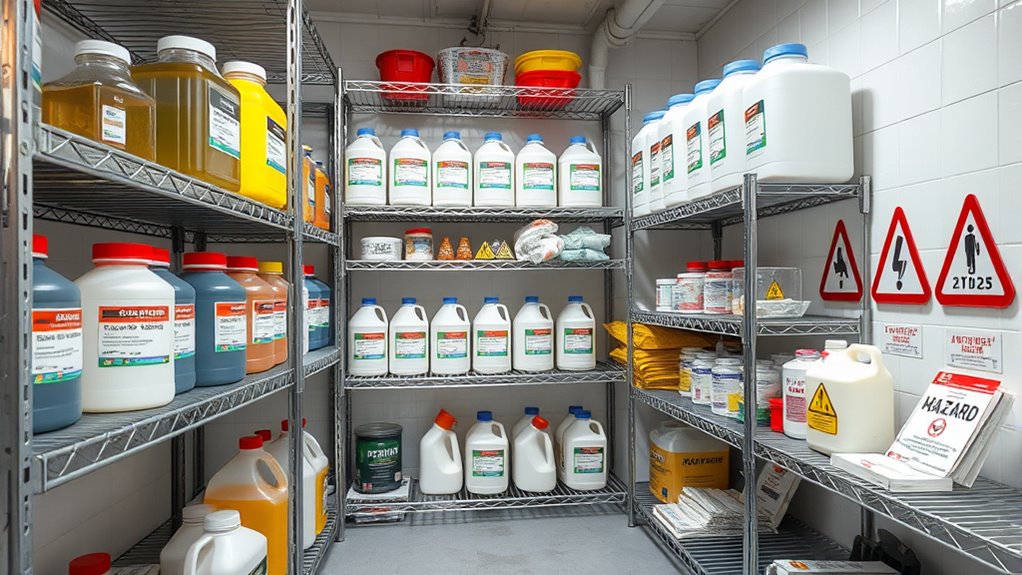
When a chemical spill occurs in a foodservice environment, quick and effective response is essential to minimize health risks and prevent contamination. First, alert staff immediately and keep customers away from the spill area. Wear appropriate personal protective equipment, such as gloves and goggles, to avoid exposure. Contain the spill by using absorbent materials or barriers to prevent it from spreading. Follow your facility’s specific spill response procedures, which might include neutralizing the chemical or carefully cleaning it up. Dispose of contaminated materials safely according to protocols. After cleanup, thoroughly wash your hands and equipment. Document the incident, noting what was spilled and how it was handled. Regular training ensures everyone knows their role, making your response more efficient and safe.
Ensuring Compliance With Regulatory Standards
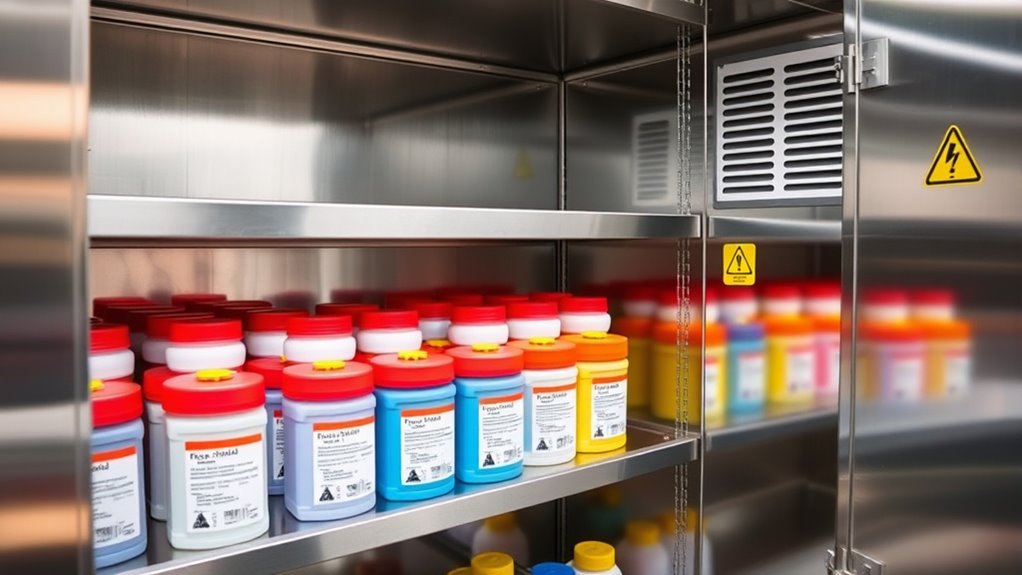
Maintaining compliance with regulatory standards is vital for guaranteeing safety and legal adherence in foodservice operations. You need to stay updated on federal, state, and local regulations that govern chemical storage. Regularly review guidelines from agencies like OSHA and the EPA to avoid violations. Proper documentation and record-keeping are essential; keep safety data sheets (SDS) accessible and updated. Conduct routine inspections to guarantee chemicals are stored correctly and labels are clear. This not only keeps your operation compliant but also protects staff and customers.
- Keep SDS and safety information readily available
- Train staff regularly on regulatory requirements
- Perform routine audits of storage areas
Frequently Asked Questions
How Often Should Chemical Storage Areas Be Audited?
You should audit your chemical storage areas regularly to make certain safety and compliance. Typically, it’s best to do so at least once a month, but more frequent checks are advisable if you handle hazardous chemicals or experience frequent changes. During audits, you’ll verify proper labeling, storage conditions, and inventory. Regular inspections help prevent accidents, keep your staff safe, and ensure you meet safety standards consistently.
What Are the Best Practices for Waste Disposal of Chemicals?
You should follow best practices for chemical waste disposal by never pouring chemicals down drains unless approved, segregate waste by chemical type, and clearly label all containers. Use approved disposal methods, such as authorized waste disposal companies, and maintain records of disposal. Always wear protective gear during disposal, and stay updated on local regulations. Proper disposal prevents environmental harm and ensures safety for everyone in your foodservice operation.
How to Train Staff on Chemical Spill Response Effectively?
To train staff on chemical spill response effectively, you need to teach them how to recognize hazards, follow proper procedures, and use safety equipment confidently. Practice makes perfect, so conduct regular drills and hands-on exercises. Reinforce key steps like evacuating the area, wearing protective gear, and reporting spills immediately. Keep training engaging and clear, so your team responds swiftly, safely, and confidently when every second counts.
Are There Specific Storage Requirements for Organic Versus Synthetic Chemicals?
You should know that organic and synthetic chemicals often have different storage needs. Organic chemicals usually require cool, dry, well-ventilated areas away from heat sources and incompatible substances. Synthetic chemicals might need special containment and temperature controls. Always read the manufacturer’s instructions and follow regulatory guidelines. Proper labeling and segregation are essential to prevent reactions or contamination. By understanding these differences, you guarantee a safer environment for everyone.
How Can Storage Areas Be Secured Against Unauthorized Access?
A chain is only as strong as its weakest link, so securing your storage area is vital. You can do this by installing sturdy locks, restricting access to authorized personnel only, and using secure cabinets or rooms. Regularly update access lists, monitor the area with security cameras, and make certain proper signage is visible. These steps help keep unauthorized individuals out, safeguarding your team and the environment from potential hazards.
Conclusion
Think of your foodservice space as a delicate orchestra, where each instrument must be perfectly tuned. Proper chemical storage is the conductor that keeps everyone safe and the operation running smoothly. When you prioritize organization, clear labeling, and staff training, you’re not just avoiding accidents—you’re protecting lives. Remember, a single spill or mistake can turn harmony into chaos. Stay vigilant, and make certain your storage practices keep your team safe and your service seamless.
